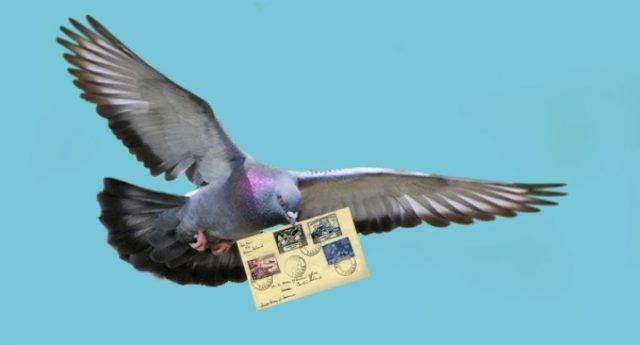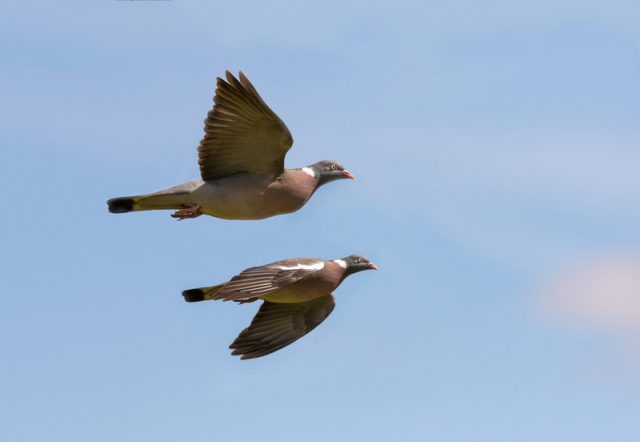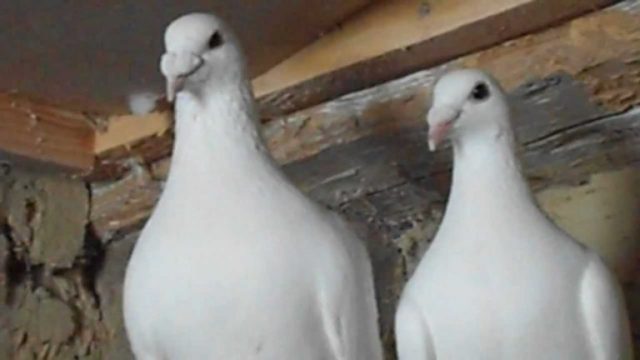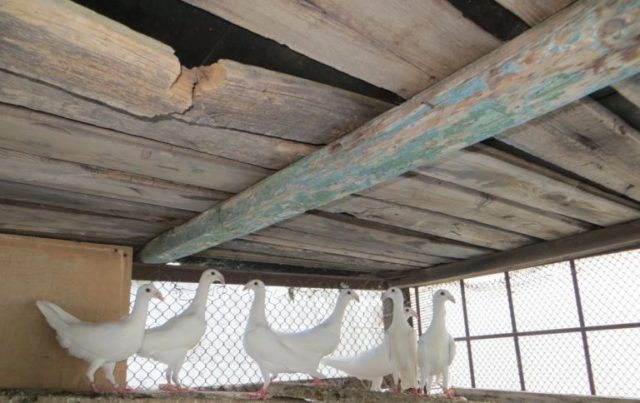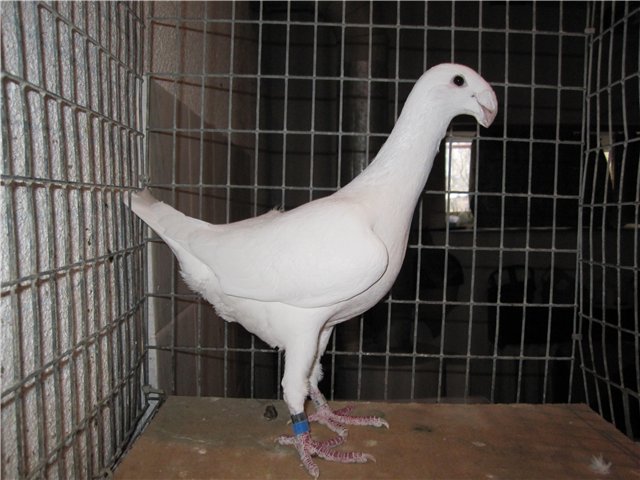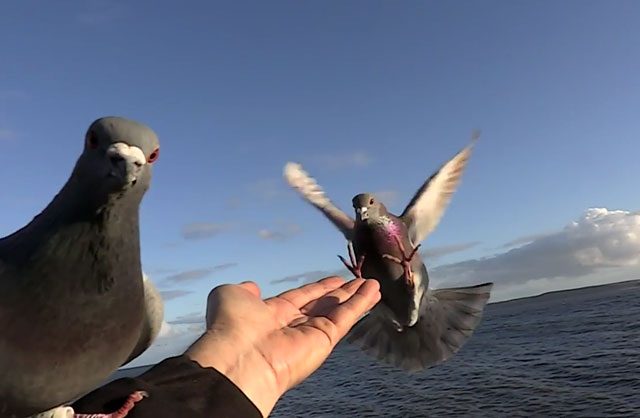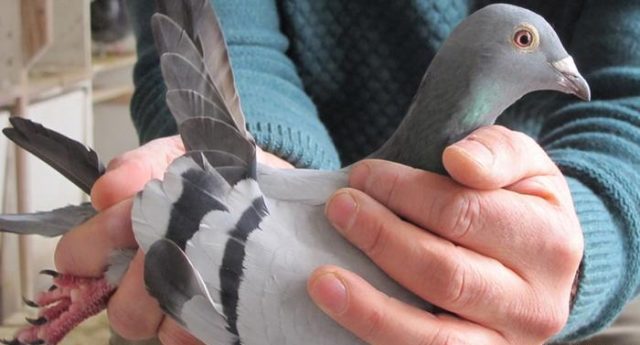Content
- 1 The history of carrier pigeons
- 2 What does a carrier pigeon look like?
- 3 How pigeon mail works
- 4 Carrier pigeon breeds with photos and names
- 5 Features of sports pigeons
- 6 How much are carrier pigeons
- 7 How carrier pigeons are taught
- 8 Breeding carrier pigeons
- 9 Interesting facts about carrier pigeons
- 10 Conclusion
In the modern age of advanced technologies, when a person is able to receive an almost instant message from an addressee who is several thousand kilometers away, rarely anyone is able to take pigeon mail seriously. Nevertheless, communication through electronic communications is also not devoid of weaknesses, because even with a simple power outage, it will be inaccessible. And the confidentiality of such messages raises many complaints. Therefore, although pigeon mail is considered hopelessly outdated and unclaimed today, it should not be completely written off.
The history of carrier pigeons
Birds, which are able to carry information messages through many hundreds and even thousands of kilometers, have been mentioned in historical documents since ancient times. Even in the Old Testament, Noah released a dove for exploration, and he returned back with an olive branch - a symbol of the fact that the earth was located somewhere nearby. Therefore, the history of the appearance of carrier pigeons goes back to ancient times.
In Ancient Egypt and in the countries of the Ancient East, pigeons were actively used as postmen. The Roman historian Pliny the Elder also mentions a similar method of mail delivery. It is known that Caesar during the Gallic War had a message with his Roman supporters using pigeons.
Among ordinary people, carrier pigeons were used to deliver love and business messages in all countries known at that time. Typically, letters were written on papyrus sheets or cloth rags and securely attached to the leg or neck of the pigeons. Already in those days, pigeon mail worked over long distances, birds were able to cover a thousand or more kilometers.
In the Middle Ages, pigeon mail developed especially intensively in European countries. It is not for nothing that almost all modern carrier pigeons are descended from the oldest Belgian breed. Homing pigeons were actively used in various armed conflicts, during sieges, as well as in public and private correspondence. After all, not a single messenger was able to match the pigeon in the promptness of delivery of the necessary information.
In the history of Russia, the first official mention of pigeon mail dates back to 1854, when Prince Golitsyn established a similar communication between his Moscow house and his country residence. Soon, the use of pigeons to convey a variety of correspondence became very popular. The "Russian Society of Pigeon Sport" was organized. The idea of a pigeon mail was happily adopted by the military. Since 1891, several official pigeon communication lines began to operate in Russia. First between the two capitals, later south and west.
Pigeon mail played an important role during the First and Second World Wars. Homing pigeons successfully overcame all obstacles and conveyed important information, for which some individuals were even awarded various awards.
After the war, pigeon mail was gradually forgotten, since the rapid development of telecommunication means of communication made the work of birds in this direction irrelevant. Nevertheless, pigeon lovers are still breeding them, but more for sporting and aesthetic pleasure. Nowadays, carrier pigeons are increasingly called sports pigeons. Competitions are regularly held in which pigeons demonstrate their beauty, strength and endurance in flight.
But, despite the fact that pigeon mail is considered outdated, in many countries to this day they use the unique abilities of these birds. So, in some European countries, it is the carrier pigeons that are trusted to deliver especially urgent or confidential information. In India and New Zealand, carrier pigeons are still used to send letters to hard-to-reach areas. And in some cities (for example, in Plymouth, England) pigeons are used as the fastest transfer of blood samples from hospitals to laboratories. Since traffic jams on the roads do not always allow you to do this quickly using conventional transport.
What does a carrier pigeon look like?
The carrier pigeon is not really a breed, but rather birds with a set of certain qualities that allow them to best cope with the task of safely transporting messages in the most difficult conditions over long distances at maximum speed. These qualities have been developed and trained in carrier pigeons for a long time. Some of them are congenital.
Homing pigeons are often larger than regular poultry. But the main thing is that they are almost a solid lump of muscles and muscles in order to easily overcome all possible obstacles. Their color can be almost any. The wings are always long and strong, the tail and legs are usually short. The beak is often quite thick, sometimes with large growths.
The most interesting in a pigeon are the eyes. In carrier pigeons, they are surrounded by naked eyelids, which can be quite wide, as in the photo.
The eyes themselves occupy a significant part of the inside of the skull and determine the stunning visual acuity in pigeons. In addition, they have the property of selective focusing. That is, they know how to concentrate their gaze on the most important things, completely ignoring everything else. And to determine the difference between light and darkness, they do not need eyes at all, they feel it with their skin.
The flight of postal individuals is more rapid and direct, and they stretch their necks more strongly than other domestic pigeons.
On average, the lifespan of carrier pigeons is about 20 years, of which they devote at least 15 years to their service.
How pigeon mail works
Pigeon mail can only work in one direction, and is based on the ability of birds to find the place where they were raised, at almost any distance and in the most difficult conditions. A person who wants to send a message to any point must pick up a carrier pigeon from there and take it with him in a cage or container. When, after a while, he needs to send a letter, he attaches it to the pigeon's leg and releases that one to freedom. The pigeon always returns to its native pigeon house. But it is impossible to send a response with the help of the same bird, and it is also difficult to make sure that the message has been received. Therefore, usually in certain places, large dovecotes were built, in which they kept both their own birds and those that were raised in other settlements. Of course, the pigeon mail had other drawbacks: on the way, predators or hunters could watch for the bird, sometimes severe weather conditions did not allow the pigeon to complete its mission to the end. However, before the invention of radio, pigeon mail was the fastest way to get a message across.
How carrier pigeons determine where to fly
Despite the fact that the carrier pigeon, released, will only have to return home, this is not always easy to do. After all, the birds were sometimes taken away in closed containers thousands of kilometers from their home and even injected into deep anesthesia along the way. Despite this, the pigeons still safely found their way home. Scientists have long been interested in how carrier pigeons determine the right direction in a distant and completely unfamiliar area and find their way to the addressee.
First, they are guided by a deeply embedded instinct, akin to that which leads migratory flocks of birds to move south in autumn and return back in spring. Only carrier pigeons return either to the place where they were born, or to where their partner or partner remained. This instinct has even received a special name - homing (from the English word "home", which means home).
The mechanism of orientation of carrier pigeons in space has not yet been fully elucidated. There are only many hypotheses, each of which has one or another confirmation. Most likely, there is a simultaneous influence of several factors at once, which help the carrier pigeons to correctly determine the direction.
First of all, carrier pigeons are distinguished by a high degree of brain and memory development, as well as sharp vision. The combination of these factors helps to capture the vast amount of information associated with multi-kilometer routes. Pigeons are capable of using the sun or other celestial bodies as a guide, and it seems that this ability is innate in them.
The presence of the so-called "natural magnet" was also revealed in birds. It allows you to determine the degree of magnetic field strength at the place of birth and residence of the pigeon. And then, referring to the magnetic lines of the entire planet, find out the correct direction of the path.
Not so long ago, a version appeared and has already been confirmed that the orientation of pigeons in space is helped by an infrasound system. These vibrations, inaudible to the human ear, with a frequency of less than 10 Hz, are perfectly perceived by pigeons. They can be transmitted over considerable distances and serve as landmarks for birds. There is also a version that carrier pigeons find their way home thanks to smells. At the very least, birds that had no sense of smell lost their way and often did not make it home.
An experiment was set up in which a tiny radio transmitter with an antenna was placed on the backs of the birds. According to the data received from him, it was possible to understand that the pigeons, returning home, do not fly in a straight line, but periodically change direction. Although the general vector of their movement remains correct. This allows us to assume that with each deviation from the route, the most convenient way of orientation is triggered.
Carrier pigeon speed
It is not for nothing that pigeon mail was considered one of the fastest before the development of modern telecommunications means. After all, a carrier pigeon flies at an average speed of 50-70 km / h. Often its flight speed reaches 90-100 km / h. And this is already more than the speed of a mail train. Depending on weather conditions, pigeons fly at an altitude of 110-150 m.
How long can a carrier pigeon fly
Until some time, it was believed that the maximum distance that a carrier pigeon can cover is about 1100 km. But later, the facts were recorded and more long travels, 1800 km, and even more than 2000 km.
What carrier pigeons usually deliver
In the old days, carrier pigeons carried mainly informational messages on fabric, papyrus or paper. They played a special role in times of various military conflicts, when it was required to keep in touch with the siege cities or deliver important orders.
Subsequently, it turned out that these birds are able to carry a load that is about 1/3 of their weight, that is, about 85-90 g.As a result, carrier pigeons began to be used not only for transmitting paper messages, but also for all kinds of experiments. Mini-cameras were attached to them, and the birds played the role of scouts and photojournalists. In criminal circles, pigeons are still used to transfer small valuable items or even bags of drugs.
Carrier pigeon breeds with photos and names
Breeds of carrier pigeons were bred rather in order to select the strongest and hardiest individuals capable of overcoming long distances and numerous obstacles. Their distinctive feature is considered to be pronounced circles around the eyes.
English
One of the oldest breeds is the English Pochtari. Their rich pedigree, like that of the Belgian carrier pigeons, dates back to the countries of the Ancient East and Egypt. They are distinguished by their beautiful appearance and excellent speed data. Birds have a large body size, a medium head and large eyes with eyelids. Feathers are tough. The beak is thick, long and straight, with warty growths. Plumage color can be almost any: white, gray, black, yellow, chestnut and variegated.
Belgian
Belgian carrier pigeons have also existed since ancient times. Their body shape is more rounded, and their chest is powerful and well-formed. The legs and neck are rather short. The tail is narrow and small. The shortened wings are usually tightly attached to the body. The eyes are dark with light eyelids. The color can be very diverse.
Russians
Russian carrier pigeons were bred by crossing European breeds with local birds. The result is rather large individuals with a graceful head shape and powerful wings, usually tightly pressed to the body and curving at the edges. The beak is sharp, of medium length. On long strong legs, feathering is completely absent. The eyes have a distinctive orange-red color. Most often, these carrier pigeons are white, but occasionally a gray-motley color is found among them.
Dragons
The so-called dragons are also known as carrier pigeons for a long time. They are very active, have excellent spatial orientation, and are unpretentious in content. The physique is dense, the head is large with large eyes. The bright orange eye color goes well with the long beak. The wings are strong, the tail is usually down.
German
German carrier pigeons were bred relatively recently using Dutch and English breeds. Breeders paid more attention to the external parameters of birds, such as fast growth and beautiful appearance. However, the flight speed was also not ignored. The pigeons turned out to be quite compact in size with a long neck, large eyes and a small strong beak. Long legs and short tail complete the overall look of the bird. Most often, white and gray plumage is found, although there are also reddish, yellowish, brown birds.
Features of sports pigeons
Today, the concept of a carrier pigeon is considered outdated. Such pigeons are usually called sports pigeons. After several years of keeping and training, the birds take part in sports competitions, where they demonstrate their flying qualities, beauty and endurance. Accordingly, all the above features of carrier pigeons are also inherent in sports individuals.
How much are carrier pigeons
Of course, an ordinary carrier pigeon can be bought quite inexpensively, on average for 800-1000 rubles. The Internet is rife with similar offers. But no one can guarantee that such a bird can achieve great success and become a winner in competitions. In special clubs and nurseries, the price for a decent sports pigeon with a pedigree starts as early as 10,000 rubles.
In European countries, breeders engaged in the breeding of elite breeds of sports pigeons sell their birds on average for 10-15 thousand euros.And one of the most expensive was a pigeon named "Dolce Vita", which sold for $ 330,000.
But this is not the limit. The most expensive carrier pigeon ever recorded in the Guinness Book of Records was a bird named Armando, sold to China at an auction in East Flanders for 1.25 million euros.
How carrier pigeons are taught
It is desirable that the carrier pigeon be born in the place where it will subsequently return. As a last resort, you can take on the education of a 20-week-old chick, but not older. Better to have your own pigeon pair or lay eggs under your pigeon.
If the chicks were born from their own pigeons, then at about the age of 3 weeks they are removed from their parents and taught to live independently.
At 2-3 months of age, the chicks begin to show interest in flying, and they can be released to fly near the dovecote. If there is a need to quickly train the bird, then after release it is chased, not allowing it to land. Under normal conditions, you can simply keep the aviary open all day.
At the same time, it is necessary to accustom the pigeon to the portable cage. At first, just close it in it for the night, then roll it in the car for short distances (up to 15-20 km) and release it.
The distance is gradually increased, bringing it up to 100 km. If at first the birds are released in flocks, then they do it one by one, so that the pigeons get used to navigate the terrain on their own.
When the pigeon returns home earlier than its owner, the exercise can be complicated by releasing the birds at dusk, in cloudy or rainy weather.
After long flights (about a day or more), pigeons need to be given proper rest before being released on a new assignment.
Breeding carrier pigeons
Typically, new dovecotes are populated with chicks between 20 and 30 days old. Each bird is ringed or branded and information about it (number, sex, date of birth) is entered into a special book. Pigeons can be considered adults already at the age of 5 months, and at 6 months they are matched. Usually a dove lays two eggs. So that they develop simultaneously, after the first egg has been laid, it is removed for a day or two in a dark, warm place, and a plastic one is placed in its place. And only after the second egg has been laid, the first one is returned to its place. Eggs incubate alternately by both parents.
If by the time of hatching both eggs are not viable, then the parental pair of pigeons must be planted to feed at least one chick from another nest. Indeed, in the goiter of the male and female, a special nutrient fluid accumulates and if you do not give it a way out, then the birds can get sick.
Chicks usually appear on the 17th day. They are blind and helpless and their parents feed them for the first 10-12 days, first with nutritious juice from the goiter, then with swollen grains. On the 14th day, the chicks of pigeons are covered with down, and the parents continue to warm them only at night.
Pigeons live in pairs and remain faithful to their mate throughout their lives. In the summer, they can make up to 3-4 clutches. In winter, in cold weather, egg laying usually stops. The best pigeons usually come from birds at the age of 3-4 years.
Pigeons are usually fed 3 times a day, feeding about 410 g of feed per bird per week. With enhanced training of homing pigeons, the amount of feed is doubled. They also need more food during molting and on especially frosty days in order to keep warm from the inside. The feed contains mainly yellow field peas and vetch. Adding chalk, sand and salt is essential for a strong eggshell. Animal food supplements contribute to the harmonious development and reproduction of pigeon chicks.Drinking water should be changed regularly. In addition, birds need bathing water in summer.
Interesting facts about carrier pigeons
Pigeons throughout the history of their existence with humans have shown themselves to be hardy and loyal creatures who have provided many invaluable services.
- In 1871, the French prince Karl Friedrich presented his mother with a dove as a gift. 4 years later, in 1875, the bird broke free and returned to Paris to its dovecote.
- Swedish scientist Andre was about to reach the North Pole in a balloon and took a pigeon with him on the journey. But the scientist was not destined to return home. While the bird flew back safely.
- There are cases when a Dutch carrier pigeon flew 2,700 km in just 18 days.
- The White Guards, leaving Sevastopol for a foreign land, took carrier pigeons with them. But, the released birds gradually returned to their homeland, having covered more than 2000 km.
- Even the high snow-capped peaks of the mountains are not a real obstacle for carrier pigeons. Cases of their return home to Brussels from Rome through the Alps have been recorded.
- Pigeons transported precious stones from England to France under their wings on the personal order of Napoleon.
- During the First World War, a carrier pigeon named Sher Ami, himself wounded in the chest and paw, delivered a message about the missing battalion, thereby helping to save 194 people from death. The bird was awarded a gold medal and a French Military Cross.
Conclusion
Pigeon mail today is not as popular as in the past. But the phenomenon of free orientation of pigeons in a completely unfamiliar area is so mysterious that the interest of scientists in decoding it has not waned to this day.
